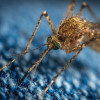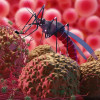.png)
Chandipura Virus Infection: All You Need to Know
Chandipura virus (CHPV) is an emerging pathogen that primarily affects children and is linked to encephalitic disease. CHPV was discovered in 1965 in the Chandipura district of Maharashtra, India, and is a member of the same family as the rabies virus—the Rhabdoviridae. The virus gained attention due to its high mortality rates during outbreaks.1,2
A glimpse into Chandipura outbreaks
Since its discovery, several outbreaks have been reported in various parts of India, particularly in Maharashtra, Gujarat, and Andhra Pradesh. The virus appears to have a seasonal pattern, with most cases occurring during the monsoon season.1,3Children under 15 years old are the main target of CHPV infections, which typically manifest as rapid-onset encephalitis with high fever, altered consciousness and seizures.3The Ministry of Health and Family Welfare of the Government of India has recorded 245 cases of acute encephalitis syndrome (AES), including 82 deaths, between early June and August 15, 2024.4 This shows that the death rates due to CHPVare alarmingly high, as it ranges from 28.6% to 78.3% within the first 48 hours of symptom onset.3 Because of this, it is identified as a deadly pathogen across the Indian subcontinent. 1 While CHPV has not been found in other nations, observation suggests that it might exist in other Asian and African nations.4
Transmission
Although other insects can act as vectors, arthropods, including mosquitoes, ticks, and sandflies, are the primary carriers of these viruses. It has been established that sandflies belonging to the genera Phlebotomus and Sergentomyia are mainly responsible for CHPV transmission. 3 Until today, no evidence suggests the possibility of human-to-human transmission.4
Symptoms
The incubation period for CHPV infection generally ranges from 2 to 4 days after being bitten by an infected sandfly. The disease usually begins with nonspecific symptoms such as:
High fever
Chills
Headache
Vomiting
As the disease progresses, more severe neurological symptoms can develop, including:
Seizures
Altered mental status
Coma
The rapid progression of the disease often leads to a high fatality rate, particularly among children. Long-term neurological problems, such as cognitive deficits (memory loss) and disabilities affecting one’s movements, can severely lower survivors' quality of life.5
Diagnosis
Diagnosing CHPV infection can be challenging due to its nonspecific initial symptoms. Laboratory tests are essential for definitive diagnosis and include:
RT-PCR: This molecular technique is employed to detect viral RNA and has been used as a standard tool for routine diagnosis.
Serology: IgM antibodies can be detected using ELISA.
Virus Isolation: The virus can be cultured in cell lines for further study. The immunofluorescent antibody technique was successfully used to detect the presence of CHPVin brain tissues during the 2003 outbreak in Andhra Pradesh, India.6,7
Treatment
Currently, there is no specific antiviral treatment for CHPV. Management primarily involves supportive care:
Intravenous fluids to manage dehydration
Antipyretics for fever
Anticonvulsants for seizures
Intensive care support in severe cases.5
Prevention
Given the lack of a specific treatment, prevention is crucial in controlling CHPV outbreaks. Key preventive measures include:
Vector Control: Reducing sandfly populations through insecticide spraying and environmental management.
Vaccines: The development of a vaccine to prevent CHPV is an ongoing endeavor. Numerous vaccination approaches are being investigated, such as recombinant viral proteins, inactivated vaccines, and live-attenuated vaccines. However, there is no approved vaccine to date.
Personal Protection: Using insect repellents, bed nets, and wearing protective clothing.
Public Awareness: Educating communities about the risks and preventive measures.4,5,8
Conclusion
Chandipura virus is a significant public health concern due to its high mortality rate and the rapid progression of the disease. Early diagnosis and supportive care are essential for improving patient outcomes. Public health strategies focusing on vector control and community education play a critical role in preventing outbreaks. Continued research is essential to develop specific treatments and vaccines for this emerging pathogen.







Please login to comment on this article